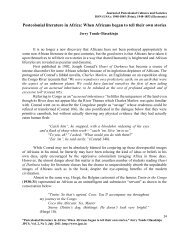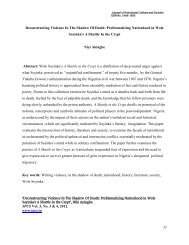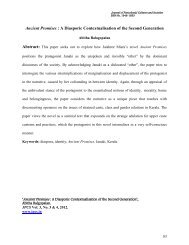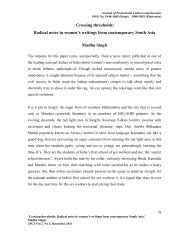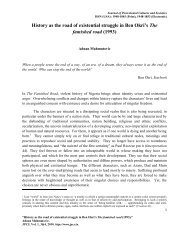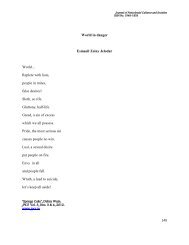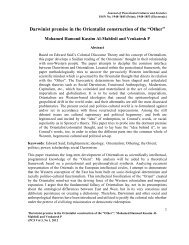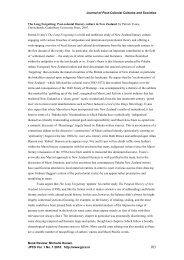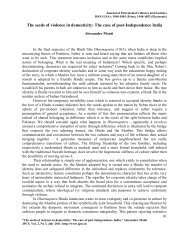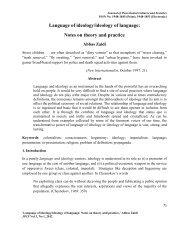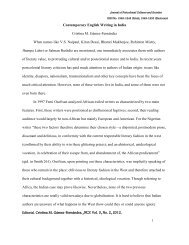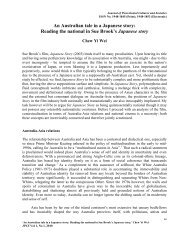'[After] That Long Silence: A Feminist Narratological Study of ... - JPCS
'[After] That Long Silence: A Feminist Narratological Study of ... - JPCS
'[After] That Long Silence: A Feminist Narratological Study of ... - JPCS
You also want an ePaper? Increase the reach of your titles
YUMPU automatically turns print PDFs into web optimized ePapers that Google loves.
Journal <strong>of</strong> Postcolonial Cultures and Societies<br />
ISSN No. 1948-1845 (Print); 1948-1853 (Electronic)<br />
[<strong>After</strong>] <strong>That</strong> <strong>Long</strong> <strong>Silence</strong>: A <strong>Feminist</strong> <strong>Narratological</strong> <strong>Study</strong> <strong>of</strong> Shashi Deshpande<br />
Maninder Kapoor and Seema Singh<br />
Abstract: As a private personal addressal <strong>of</strong> the constraints and commitments that muffle the<br />
voice <strong>of</strong> the woman writer, Shashi Deshpande’s <strong>That</strong> <strong>Long</strong> <strong>Silence</strong> (1988) deals directly with<br />
feminist narratological preoccupation with the context <strong>of</strong> how a woman writes. Deshpande<br />
expertly handles the use <strong>of</strong> the first person homodiegetic narrator to build a sense <strong>of</strong> intimacy<br />
and empathy with the reader, and also to add to the touch <strong>of</strong> real life authenticity which<br />
facilitates the reader’s sense <strong>of</strong> identification with the situations depicted in the novel. As in most<br />
women’s writing, the plot is minimal, and is restricted to the mind <strong>of</strong> the narrator, which is the<br />
site for the quest for selfhood that formulates the substance <strong>of</strong> the novel. Shashi Deshpande<br />
exploits the flashback and stream <strong>of</strong> consciousness techniques to their full potential to lay bare<br />
the innards <strong>of</strong> the intimate personal story <strong>of</strong> a woman. Considering the nature <strong>of</strong> the subject<br />
matter, perhaps this is the only technique permissible. <strong>That</strong> <strong>Long</strong> <strong>Silence</strong> as a representative<br />
sample <strong>of</strong> women’s writing exposes stereotypical images <strong>of</strong> women as meaningless constructions<br />
<strong>of</strong> the male imagination. The novel also shows instances <strong>of</strong> “reflexive perception” and<br />
“inversion” which have been identified as characteristic features <strong>of</strong> women’s writing. Also the<br />
presence <strong>of</strong> a mad woman in the text allows us to interpret the novel from the perspective <strong>of</strong><br />
‘[<strong>After</strong>] <strong>That</strong> <strong>Long</strong> <strong>Silence</strong>: A <strong>Feminist</strong> <strong>Narratological</strong> <strong>Study</strong> <strong>of</strong> Shashi Deshpande’,<br />
Maninder Kapoor and Seema Singh.<br />
<strong>JPCS</strong> Vol. 3, No. 2, 2012.<br />
www.jpcs.in<br />
63
Journal <strong>of</strong> Postcolonial Cultures and Societies<br />
ISSN No. 1948-1845 (Print); 1948-1853 (Electronic)<br />
Gilbert and Gubar. In the light <strong>of</strong> certain feminist theories, certain recognizable strains <strong>of</strong><br />
women’s writing may thus be identified.<br />
Keywords: feminist narratological application, selfhood, stream <strong>of</strong> consciousness, inversion,<br />
reflexive perception.<br />
[<strong>After</strong>] <strong>That</strong> <strong>Long</strong> <strong>Silence</strong>: A <strong>Feminist</strong> <strong>Narratological</strong> <strong>Study</strong> <strong>of</strong> Shashi Deshpande<br />
Maninder Kapoor and Seema Singh<br />
When Femi Os<strong>of</strong>isan in “Warriors <strong>of</strong> a Failed Utopia” identifies African exiled writers as<br />
“disillusioned fugitives” (qtd. in Cazenave and Celerier 131) writing for Europe and America, he<br />
could equally well be referring to the elite tribe <strong>of</strong> Indian writers with foreign credentials<br />
investing in foreign audiences, and basking in the warmth <strong>of</strong> foreign recognition. While<br />
glittering awards are no doubt attractive, this paper honours one who dared to remain behind.<br />
Shashi Deshpande (1938- ) is singular among Indian English women writers in the sense<br />
that she deliberately refrains from the temptation <strong>of</strong> succumbing to literary fashion in the West.<br />
She refuses to exoticize India in her fiction. She disobeys the herd instinct, and does not belong<br />
to the “celebrity club” <strong>of</strong> Indian writers who pander exclusively to the western palate and are<br />
prolific producers <strong>of</strong> fiction meant only for export. When Tobias Wachinger speaks<br />
condescendingly <strong>of</strong> the “imagining” (72) <strong>of</strong> a celebrity community <strong>of</strong> Indian novels as a direct<br />
‘[<strong>After</strong>] <strong>That</strong> <strong>Long</strong> <strong>Silence</strong>: A <strong>Feminist</strong> <strong>Narratological</strong> <strong>Study</strong> <strong>of</strong> Shashi Deshpande’,<br />
Maninder Kapoor and Seema Singh.<br />
<strong>JPCS</strong> Vol. 3, No. 2, 2012.<br />
www.jpcs.in<br />
64
Journal <strong>of</strong> Postcolonial Cultures and Societies<br />
ISSN No. 1948-1845 (Print); 1948-1853 (Electronic)<br />
consequence <strong>of</strong> the ministrations <strong>of</strong> western criteria for excellence, he does not even<br />
acknowledge Shashi Deshpande as a remote presence on the literary horizon. In Wachinger’s<br />
words, “the western metropole is <strong>of</strong> central importance, both as the commodifying, <strong>of</strong>ten<br />
enabling power behind narrative production and as the target audience <strong>of</strong> these novels” (72).<br />
Home-grown Shashi Deshpande is however immune to the demands <strong>of</strong> the western agenda and<br />
targets an indigenous audience. While Deshpande abstains from “pickling” (Wachinger 74)<br />
India, she wryly acknowledges that she was never the cynosure <strong>of</strong> critical attention and began to<br />
be noticed only after she was published abroad. Significantly, Deshpande expresses a cautionary<br />
note when she admits that western recognition enforces its own criteria, and demands a certain<br />
measure <strong>of</strong> conformity: “<strong>After</strong> the Booker and the Pulitzer, Indian writers have been under<br />
pressure to conform. Once our writers get over that and write honestly—doesn’t matter whether<br />
a western publisher wants it or not—we’ll have much better writing” (De 1).<br />
Deshpande writes honestly, and scrupulously avoids the cardinal sin <strong>of</strong> betraying the<br />
subaltern by presenting the East within the packaging <strong>of</strong> the West to entice the West. Her claim<br />
to fame lies elsewhere as well. Arnab Chakladar recognises her unique strength while he brings<br />
attention to the irony that texts that do not relate to national allegories, or East/West encounters<br />
or a transnational subjectivity are marginalised or ignored. Appreciating the sensitively local<br />
flavour <strong>of</strong> her oeuvre, he states:<br />
. . . the very local concerns <strong>of</strong> a writer such as Deshpande, her very lack <strong>of</strong> a<br />
global address in her style or themes, unsettle the configurations <strong>of</strong> “India” and<br />
‘[<strong>After</strong>] <strong>That</strong> <strong>Long</strong> <strong>Silence</strong>: A <strong>Feminist</strong> <strong>Narratological</strong> <strong>Study</strong> <strong>of</strong> Shashi Deshpande’,<br />
Maninder Kapoor and Seema Singh.<br />
<strong>JPCS</strong> Vol. 3, No. 2, 2012.<br />
www.jpcs.in<br />
65
Journal <strong>of</strong> Postcolonial Cultures and Societies<br />
ISSN No. 1948-1845 (Print); 1948-1853 (Electronic)<br />
“Indian Literature” that are willy-nilly created by the seemingly unconscious act<br />
<strong>of</strong> text-selection . . . Her writings not only expand our understanding <strong>of</strong> Indian<br />
women’s literature, or <strong>of</strong> representations <strong>of</strong> women’s agency, but also expand our<br />
understanding <strong>of</strong> the complex relationships that mediate community and tradition,<br />
culture and nation, and <strong>of</strong> Indian literature as a whole. (94)<br />
Besides six short story collections, Shashi Deshpande’s fiction includes Roots and<br />
Shadows (1983), The Dark Holds No Terrors (1980), <strong>That</strong> <strong>Long</strong> <strong>Silence</strong> (1988), The Binding<br />
Vine (1993), A Matter <strong>of</strong> Time (1996), and Small Remedies (2000). These novels are undoubtedly<br />
a searing portrait <strong>of</strong> Indian womanhood in distress. Also, they labour under an obsessive<br />
compulsive preoccupation with woman’s quest for selfhood. Her women protagonists—Indu,<br />
Saru, Jaya, Urmila, and Sumi invariably undertake an arduous journey which transports them<br />
from a state <strong>of</strong> self-effacement to one <strong>of</strong> self-realisation. Yet Deshpande shies away from the<br />
label <strong>of</strong> a “feminist” writer. She frankly admits: “I don’t like to call myself a feminist writer. I’m<br />
a feminist but I don’t write to propagate any ‘ism’” (De 1). While Deshpande fights shy <strong>of</strong> the<br />
straitjacket imposed by “isms”, her work presents a nuanced rendition <strong>of</strong> the power <strong>of</strong> gender to<br />
decide destiny within an Indian situation. This paper singles out the Sahitya Akademi award-<br />
winning novel, <strong>That</strong> <strong>Long</strong> <strong>Silence</strong> (1988) for its overtly conscious concern with the mechanics <strong>of</strong><br />
women’s writing, and assesses its usefulness as raw material for a feminist narratological<br />
application. Robyn Warhol has defined “feminist narratology” as the study <strong>of</strong> narrative structures<br />
and strategies in the context <strong>of</strong> the cultural constructions <strong>of</strong> gender (21). Undoubtedly, different<br />
‘[<strong>After</strong>] <strong>That</strong> <strong>Long</strong> <strong>Silence</strong>: A <strong>Feminist</strong> <strong>Narratological</strong> <strong>Study</strong> <strong>of</strong> Shashi Deshpande’,<br />
Maninder Kapoor and Seema Singh.<br />
<strong>JPCS</strong> Vol. 3, No. 2, 2012.<br />
www.jpcs.in<br />
66
Journal <strong>of</strong> Postcolonial Cultures and Societies<br />
ISSN No. 1948-1845 (Print); 1948-1853 (Electronic)<br />
cultures differently construct gender. This paper shall attempt to dissect the extent to which<br />
gender as constructed in the Indian context dictates the terms and conditions <strong>of</strong> narration.<br />
For Deshpande, writing itself is a means to self-discovery—a medium by way <strong>of</strong> which<br />
she announces to the world that there is more to her than merely being “Mrs Deshpande,<br />
Raghunandan’s mother, Vikram’s mother”. Galled at the step motherly treatment accorded to<br />
women’s writing, she recalls:<br />
I feel I came through only because I had faith in myself. The desire to say<br />
something was so strong. <strong>That</strong> was hard when my whole life was considered<br />
unimportant, my work was considered unimportant, even writing by women was<br />
considered unimportant. Many women are silenced by lack <strong>of</strong> time. If I admire<br />
anything in myself, it’s only that I kept on. It’s easy to give up. (De 1)<br />
At the same time Deshpande expresses a deep resentment at the casual dismissal <strong>of</strong> women’s<br />
writing as substandard: “If you’re writing about domestic things or the family, they immediately<br />
put you in an inferior slot. Somehow, women’s writing is always the zenana. It’s <strong>of</strong>ten called by<br />
the derogatory term, adige mane sahitya” (De 1). Deshpande insists that women’s writing needs<br />
to be read differently, that a story about a kitchen need not be belittled when it’s about a human<br />
being trying to place herself within relationships, people, and ideas. Deshpande’s preoccupation<br />
with the themes, processes, and reception <strong>of</strong> women’s writing finds ideal manifestation in <strong>That</strong><br />
<strong>Long</strong> <strong>Silence</strong>. Interestingly, these are the very issues that constitute the subject matter <strong>of</strong> feminist<br />
narratology when it declares that gender makes a difference to narrative. However, as is<br />
‘[<strong>After</strong>] <strong>That</strong> <strong>Long</strong> <strong>Silence</strong>: A <strong>Feminist</strong> <strong>Narratological</strong> <strong>Study</strong> <strong>of</strong> Shashi Deshpande’,<br />
Maninder Kapoor and Seema Singh.<br />
<strong>JPCS</strong> Vol. 3, No. 2, 2012.<br />
www.jpcs.in<br />
67
Journal <strong>of</strong> Postcolonial Cultures and Societies<br />
ISSN No. 1948-1845 (Print); 1948-1853 (Electronic)<br />
generally acknowledged, gender is socially constructed, is open to variation across and within<br />
cultures, and is not a monolithic construct that can unequivocally define a concept like women’s<br />
writing (Page 52). Yet it may be averred that despite the nuances in the concept <strong>of</strong> gender, <strong>That</strong><br />
<strong>Long</strong> <strong>Silence</strong> serves as an interesting example within the Indian cultural context to test the<br />
veracity <strong>of</strong> feminist narratological principles. Such an illustration from Indian women’s writing<br />
would also enable us to deflect the allegation <strong>of</strong> Eurocentrism that is <strong>of</strong>ten levelled against<br />
feminist narratology.<br />
Indeed, <strong>That</strong> <strong>Long</strong> <strong>Silence</strong> speaks the language <strong>of</strong> feminist narratology to make an<br />
explicitly eloquent comment on the process <strong>of</strong> women’s writing. The feminist narratological<br />
project deliberates over the existence <strong>of</strong> “a woman’s writing” and “a female tradition” and<br />
demands attention to “the context <strong>of</strong> how stories are told, by whom and for whom” (Mezei 1).<br />
Significantly, these are the very questions that figure prominently on Deshpande’s agenda in<br />
<strong>That</strong> <strong>Long</strong> <strong>Silence</strong>. Here is a woman writing for women, in the real world as well as the fictional<br />
world, in a deliberate attempt to unburden her soul <strong>of</strong> “the weight <strong>of</strong> that long silence <strong>of</strong> one half<br />
<strong>of</strong> the world” (qtd. in Deshpande epigraph). This quotation from Elizabeth Robins’ speech to the<br />
Women Writers Suffrage League (WWSL) in 1907 becomes the source <strong>of</strong> not only the title, but<br />
also the epigraph to the novel. Undoubtedly, the novel breaks “that long silence” and voices the<br />
agony <strong>of</strong> the female population <strong>of</strong> India, and perhaps even <strong>of</strong> the world.<br />
At the very outset, the reader is initiated into the nitty gritties <strong>of</strong> women’s writing. The<br />
woman narrator speaks in the first person to directly address the reader, establishing thereby a<br />
‘[<strong>After</strong>] <strong>That</strong> <strong>Long</strong> <strong>Silence</strong>: A <strong>Feminist</strong> <strong>Narratological</strong> <strong>Study</strong> <strong>of</strong> Shashi Deshpande’,<br />
Maninder Kapoor and Seema Singh.<br />
<strong>JPCS</strong> Vol. 3, No. 2, 2012.<br />
www.jpcs.in<br />
68
Journal <strong>of</strong> Postcolonial Cultures and Societies<br />
ISSN No. 1948-1845 (Print); 1948-1853 (Electronic)<br />
close bond <strong>of</strong> intimacy and empathy that links the “I” and the “you” in a comfort zone <strong>of</strong><br />
familiarity. It is stated that writing requires a brand <strong>of</strong> ruthlessness, detachment, and distance.<br />
Further, writing is compared to the process <strong>of</strong> childbirth. To quote: “I am reminded <strong>of</strong> the<br />
process <strong>of</strong> childbirth. The only memory that remains with me is that <strong>of</strong> fear, a fear that I was<br />
losing control over my own body. And so I resisted” (1). There is then an insistent identification<br />
with woman’s exclusive experience.<br />
Subsequently, the narrator reveals her identity as Mohan’s wife, and to use Susan<br />
Lanser’s terminology, the narrative act acquires the dimensions <strong>of</strong> status, contact, and stance (86-<br />
94). Together these three components constitute the narrative act, and delineate Lanser’s poetics<br />
<strong>of</strong> “point <strong>of</strong> view”. When the readers directly register the narrating “I” as Mohan’s wife and as a<br />
struggling writer, that “I” displays the status <strong>of</strong> a homodiegetic narrator making direct contact<br />
with “you”, representative by implication <strong>of</strong> a category <strong>of</strong> women readers sensitive to and<br />
cognizant <strong>of</strong> the trials and tribulations <strong>of</strong> such writing. Simultaneously, the “I” reveals her<br />
“stance” towards the discourse content that is to be initiated. This is to be a painful though<br />
cathartic attempt at self revelation. Thus the “status”, “contact”, and “stance” <strong>of</strong> the narrating “I”<br />
help articulate our comprehension <strong>of</strong> the author’s textual persona, or to use narratological<br />
terminology, the “implied author”. As Seymour Chatman reminds us, “it is essential not to<br />
confuse author and narrator” (147). What we reconstruct from the narrative is the “implied<br />
author”, who is not the narrator, “but rather the principle that invented the narrator, along with<br />
‘[<strong>After</strong>] <strong>That</strong> <strong>Long</strong> <strong>Silence</strong>: A <strong>Feminist</strong> <strong>Narratological</strong> <strong>Study</strong> <strong>of</strong> Shashi Deshpande’,<br />
Maninder Kapoor and Seema Singh.<br />
<strong>JPCS</strong> Vol. 3, No. 2, 2012.<br />
www.jpcs.in<br />
69
Journal <strong>of</strong> Postcolonial Cultures and Societies<br />
ISSN No. 1948-1845 (Print); 1948-1853 (Electronic)<br />
everything else in the narrative, that stacked the cards in this particular way, had these things<br />
happen to these characters in these words or images” (147).<br />
Yet in <strong>That</strong> <strong>Long</strong> <strong>Silence</strong>, both the author and narrator seem suspiciously similar. Both<br />
are urban, middle-class, educated, pr<strong>of</strong>essional women with university degrees. Shashi<br />
Deshpande is a woman writer who churned out saccharine romances for Femina and Eve’s<br />
Weekly before she acquired international status. The narrator Jaya is also an aspiring writer who<br />
bottles her breath to mouth inane adolescent fantasies about innocent young girls who mated<br />
themselves with the right men. Her humble claim to fame is the regular weekly column on<br />
blissful “Seeta” for Woman’s World—expertly written light humorous pieces about the travails <strong>of</strong><br />
a middle-class housewife—stories that are supremely successful in building a happy illusion that<br />
does not even remotely suggest the actual truth. These are stories whose implied author is in<br />
Kamat’s words, one <strong>of</strong> the novel’s characters, “plump good humoured pea brained but shrewd,<br />
devious, skimming over life . . . ” (149). As a woman writer, Jaya must sift her subject matter<br />
with care, and skim over life. She must throttle her real self, and close the door firmly on all<br />
those women she had been clamouring to write about, but could not because she ran the risk <strong>of</strong><br />
their remotely resembling either Mohan’s mother or aunt or her mother or aunt. Seeta was the<br />
safest bet—a convenient fiction acceptable to Mohan—not ugly things about a man and a woman<br />
whom people might mistake for Mohan and Jaya, and thus violate Mohan’s sense <strong>of</strong> dignity and<br />
propriety. Jaya cannot counter his accusation <strong>of</strong> “exhibitionism” nor can she explain that while<br />
she makes use <strong>of</strong> personal experience as raw material, she transmutes it into something<br />
‘[<strong>After</strong>] <strong>That</strong> <strong>Long</strong> <strong>Silence</strong>: A <strong>Feminist</strong> <strong>Narratological</strong> <strong>Study</strong> <strong>of</strong> Shashi Deshpande’,<br />
Maninder Kapoor and Seema Singh.<br />
<strong>JPCS</strong> Vol. 3, No. 2, 2012.<br />
www.jpcs.in<br />
70
Journal <strong>of</strong> Postcolonial Cultures and Societies<br />
ISSN No. 1948-1845 (Print); 1948-1853 (Electronic)<br />
completely different. Since she cannot explain, she must abjure or place her marriage in<br />
jeopardy. Rather than invite such a disaster, she prefers to masquerade as what she is not. Thus<br />
she corks her anger, abandons ambition, consents to being pea brained, and emulates Seeta, who<br />
as the heroine <strong>of</strong> the Hindu epic Ramayana embodies the Indian epitome <strong>of</strong> female perfection.<br />
While she does take recourse to self pity, write under a false name, fear failure, and find excuses<br />
for it, the end <strong>of</strong> the novel finds her abandoning fear and restraint to follow freely the dictates <strong>of</strong><br />
her desire, buoyed by the recognition that she must erase the silence, and speak “Sanskrit”, and<br />
not the “Prakrit” that women characters were condemned to in Sanskrit drama. The allusion is<br />
subtle. She had been speaking “Prakrit” all along, the language she believed Mohan wanted to<br />
hear. Now finally on an even keel, she can share the same language, and revel in its power. She<br />
has indeed come a long way, and this journey forms the substance <strong>of</strong> the novel.<br />
Not only does the novel trace the evolution <strong>of</strong> the woman writer, it also captures a<br />
particular socio-cultural milieu that is peculiar to India and thus establishes the “context” which<br />
is an important concern for feminist narratology (Mezei 1). The subject position adopted is that<br />
<strong>of</strong> the “Indian” woman writer for whom writing or any pr<strong>of</strong>ession for that matter can only be<br />
secondary as the only admissible career or pr<strong>of</strong>ession is the husband. As Jaya once tells Mohan,<br />
“I know you better than you know yourself” (75) to further deliberate that he was her career, her<br />
pr<strong>of</strong>ession, her means <strong>of</strong> livelihood, and not to know him amounted to failing at her job. In such<br />
a situation writing can never be a full-blooded passion, or even a consuming career. It can only<br />
enjoy the status <strong>of</strong> a respectable hobby that can never be taken very seriously. By problematizing<br />
‘[<strong>After</strong>] <strong>That</strong> <strong>Long</strong> <strong>Silence</strong>: A <strong>Feminist</strong> <strong>Narratological</strong> <strong>Study</strong> <strong>of</strong> Shashi Deshpande’,<br />
Maninder Kapoor and Seema Singh.<br />
<strong>JPCS</strong> Vol. 3, No. 2, 2012.<br />
www.jpcs.in<br />
71
Journal <strong>of</strong> Postcolonial Cultures and Societies<br />
ISSN No. 1948-1845 (Print); 1948-1853 (Electronic)<br />
such a situation, the novel is able to foreground not only Jaya’s predicament, but also the writer’s<br />
dilemma.<br />
Interestingly, Shashi Deshpande is an Indian English woman writer writing about the<br />
travails <strong>of</strong> another Indian English woman writer. When Jaya manoeuvres her way through<br />
problems and pitfalls to actually write her story towards the end <strong>of</strong> the novel, the reader is<br />
constrained into believing in the illusion that what is actually being read is Jaya’s novel. The use<br />
<strong>of</strong> the first person further helps to preserve the illusion, and enables the merging <strong>of</strong> the persona<br />
<strong>of</strong> Shashi Deshpande with that <strong>of</strong> Jaya, perhaps committing in the process the same cardinal sin<br />
that Mohan has all along been fearful <strong>of</strong> when he says: “. . . all those people who read this and<br />
know us . . . will think I am this kind <strong>of</strong> a man, they will think I am this man. How can I look<br />
anyone in the face again” (144). The readers are unable to heed Seymour Chatman’s warning and<br />
tend to confuse the author with the narrator. The real world and the fictional world coalesce, and<br />
the voice <strong>of</strong> the author is indistinguishable from that <strong>of</strong> the narrator. Very relevant at this<br />
juncture is Monroe Beardsley’s argument when he says that: “ . . . the speaker <strong>of</strong> a literary work<br />
cannot be identified with the author—and therefore the character and condition <strong>of</strong> the speaker<br />
can be known by internal evidence alone—unless the author has provided a pragmatic context, or<br />
acclaim <strong>of</strong> one that connects the speaker with himself” (265).<br />
Significantly, Shashi Deshpande does provide such a context that connects the speaker<br />
with herself when she says: “And then I wrote <strong>That</strong> <strong>Long</strong> <strong>Silence</strong> almost entirely a woman’s<br />
novel, nevertheless a book about the silencing <strong>of</strong> one-half <strong>of</strong> humanity. A lifetime <strong>of</strong><br />
‘[<strong>After</strong>] <strong>That</strong> <strong>Long</strong> <strong>Silence</strong>: A <strong>Feminist</strong> <strong>Narratological</strong> <strong>Study</strong> <strong>of</strong> Shashi Deshpande’,<br />
Maninder Kapoor and Seema Singh.<br />
<strong>JPCS</strong> Vol. 3, No. 2, 2012.<br />
www.jpcs.in<br />
72
Journal <strong>of</strong> Postcolonial Cultures and Societies<br />
ISSN No. 1948-1845 (Print); 1948-1853 (Electronic)<br />
introspection went into this novel, the one closest to me personally, the thinking and ideas in this<br />
are closest to my own” (Jain 210). A statement as deliberate and categorical as this makes it<br />
possible to place it in the context <strong>of</strong> Susan Lanser’s contention that if literature is to be<br />
understood as a communicative process between writer and reader where the former intends by<br />
different means to persuade the latter to share the perceptual and ideological vision <strong>of</strong> the world<br />
he or she has portrayed, then an elaborate articulation <strong>of</strong> the author’s textual persona clearly<br />
contributes to the reader’s interpretation <strong>of</strong> the story. Deshpande’s statement ensures and<br />
legitimizes the identification <strong>of</strong> the narrator with the author to the extent that the reader begins to<br />
think <strong>of</strong> Jaya as Deshpande’s textual persona, as a mouthpiece not only for her, but also for the<br />
one half <strong>of</strong> humanity that she so powerfully represents. Further, that one-half <strong>of</strong> humanity is able<br />
to empathize with Jaya, and find their struggle reflected in her trauma is what accounts for the<br />
novel’s success. As Rajeswari Sunder Rajan puts it: “So compellingly realistic is this rendering<br />
that no Indian woman reader can read this novel without a steady, sympathetic identification, and<br />
indeed frequent shocks <strong>of</strong> recognition” (78).<br />
To argue further, such sensitive empathy is possible to a large extent through<br />
Deshpande’s expert use <strong>of</strong> the first person narrative technique. When the narrating “I” and the<br />
experiencing “I” belong to the protagonist as in <strong>That</strong> <strong>Long</strong> <strong>Silence</strong>, what the reader enjoys is the<br />
insight <strong>of</strong> the experiencing “I” functioning as an internal focalizer. When the text is so<br />
exclusively attuned to the spatio-temporal, emotional, and ideological perception <strong>of</strong> that<br />
narrating and experiencing “I”, the readers are magnetically drawn into the story, and invited to<br />
‘[<strong>After</strong>] <strong>That</strong> <strong>Long</strong> <strong>Silence</strong>: A <strong>Feminist</strong> <strong>Narratological</strong> <strong>Study</strong> <strong>of</strong> Shashi Deshpande’,<br />
Maninder Kapoor and Seema Singh.<br />
<strong>JPCS</strong> Vol. 3, No. 2, 2012.<br />
www.jpcs.in<br />
73
Journal <strong>of</strong> Postcolonial Cultures and Societies<br />
ISSN No. 1948-1845 (Print); 1948-1853 (Electronic)<br />
co-experience what it is like to be a participant in the unfolding events, which in turn accounts<br />
for the sense <strong>of</strong> empathy and emotional identification. The disadvantage, however, <strong>of</strong> the first<br />
person narrative technique is that first person narrators are restricted to ordinary human<br />
situations (Lanser 16). They cannot be in two places at the same time. They do not know what<br />
will happen in the future. They cannot narrate the story <strong>of</strong> their own death, and they can never<br />
know for certain what other characters think or thought. In the case <strong>of</strong> <strong>That</strong> <strong>Long</strong> <strong>Silence</strong><br />
significantly, these are no disadvantages, but actually serve to advantage because they allow<br />
Deshpande an intensity and concentration <strong>of</strong> focus that blasts the woman upstage centre and<br />
relegates all else to the peripheral sidelines. Thus the narrative acquires immediacy, authority,<br />
focus, and voice precisely because Deshpande limits and lopsides her point <strong>of</strong> view to the<br />
specific focus <strong>of</strong> a woman and her quest for selfhood. When the quest for selfhood is seen as the<br />
leitmotif <strong>of</strong> the novel, it becomes clear why the narrative stacks its cards in a particular way, why<br />
certain things happen to the woman protagonist in certain words and images. There is no plot.<br />
Nothing much happens, and what happens is rendered succinctly by the narrator herself when<br />
she sifts through irrelevant details to pounce on major events that define her bio-data: “I was<br />
born. My father died when I was fifteen. I got married to Mohan. I have two children and I did<br />
not let a third live” (2). Here in stark outline is a stereotypical pattern that plots the lives <strong>of</strong> most<br />
women. Here is not the site <strong>of</strong> the action. The action lies in the charting <strong>of</strong> the quest for selfhood<br />
which in turn, controls the narrative.<br />
‘[<strong>After</strong>] <strong>That</strong> <strong>Long</strong> <strong>Silence</strong>: A <strong>Feminist</strong> <strong>Narratological</strong> <strong>Study</strong> <strong>of</strong> Shashi Deshpande’,<br />
Maninder Kapoor and Seema Singh.<br />
<strong>JPCS</strong> Vol. 3, No. 2, 2012.<br />
www.jpcs.in<br />
74
Journal <strong>of</strong> Postcolonial Cultures and Societies<br />
ISSN No. 1948-1845 (Print); 1948-1853 (Electronic)<br />
Right at the outset, the narrating “I” or Jaya dwells at length over the pitfalls that such a<br />
quest for rediscovering one’s true self necessarily involves: “Self-revelation is a cruel process . . .<br />
the real you never emerges . . . ten different mirrors show you ten different faces” (1). In the<br />
course <strong>of</strong> the narrative, some <strong>of</strong> the faces <strong>of</strong> Jaya are revealed as also the struggle she makes to<br />
project and preserve the face that family and society demand <strong>of</strong> her—to be the happy mother <strong>of</strong><br />
the advertising visual, serving her family with “love and care”, to be the living embodiment <strong>of</strong><br />
Seeta, Savitri, and Draupadi, to be “s<strong>of</strong>t, smiling, placid, motherly” Suhasini - the name Mohan<br />
gives her when she marries him. The halo and the mask are constantly slipping while Jaya<br />
clamours to make her presence felt. Suhasini and Jaya are constantly at battle, and that battle is<br />
well articulated by Shakuntala Bharvani when she says: “The woman <strong>of</strong> today, therefore<br />
speaking in the language <strong>of</strong> psychology has a near schizophrenic personality. One side steadily<br />
“accepts” while the other craves to speak, to think, and express the life <strong>of</strong> the mind” (150). Thus<br />
Suhasini and Jaya are different dimensions to the same personality. It would be more appropriate<br />
then to say that in the attempt to be Suhasini, Jaya is mislaid. Suhasini rejects speech and anger<br />
as “unwomanly”, and throttles her writing ambitions. Jaya resurfaces, and insists on<br />
introspection and self analysis, on speech and articulation, and on bold confrontation with the<br />
phantoms <strong>of</strong> the past and with the challenges <strong>of</strong> the future. It is with a new maturity that Jaya<br />
returns to her writing to rediscover the child within her—“a child, wearing a dress with pockets<br />
for the first time . . . heady with the excitement <strong>of</strong> finding unexpected resources within herself”<br />
(187). Thus writing becomes for her a cathartic outlet, and a concrete manifestation <strong>of</strong> the<br />
‘[<strong>After</strong>] <strong>That</strong> <strong>Long</strong> <strong>Silence</strong>: A <strong>Feminist</strong> <strong>Narratological</strong> <strong>Study</strong> <strong>of</strong> Shashi Deshpande’,<br />
Maninder Kapoor and Seema Singh.<br />
<strong>JPCS</strong> Vol. 3, No. 2, 2012.<br />
www.jpcs.in<br />
75
Journal <strong>of</strong> Postcolonial Cultures and Societies<br />
ISSN No. 1948-1845 (Print); 1948-1853 (Electronic)<br />
unexpected resources within herself. This, however, is possible only with the recognition that as<br />
Mohan’s wife, she had cut <strong>of</strong>f the bits <strong>of</strong> her that had refused to be Mohan’s wife, and that such<br />
fragmentation is neither possible nor feasible. She must reconcile the different dimensions <strong>of</strong> her<br />
personality to project a composite whole. The novel ends on a positive note <strong>of</strong> affirmation with<br />
Jaya looking forward with new hope to a new beginning with Mohan, and declaring: “I will have<br />
to speak, to listen. I will have to erase the silence between us” (192). Jaya’s quest for selfhood<br />
runs parallel to her evolution as a writer. Both journeys find their apogee in the actual event <strong>of</strong><br />
writing.<br />
Interestingly, technique matches theme. Since the theme involves a search for identity,<br />
most <strong>of</strong> the action is psychological, and takes place in the mind <strong>of</strong> the protagonist. The actual<br />
physical action covers the space <strong>of</strong> only a few days, but unleashes a train <strong>of</strong> thought that takes us<br />
backward and forward in time through recollection and reflection, dream sequences, recalled<br />
conversations, and secret confidences that actualise the quest for identity in concrete terms.<br />
These forays into the past pursue the protagonist’s stream <strong>of</strong> consciousness to inform the reader<br />
<strong>of</strong> the host <strong>of</strong> family that people the past, and the events that punctuate it. This enables the<br />
readers to piece together the jigsaw <strong>of</strong> thoughts and feelings that not only impact the present, but<br />
also initiate and enable the search for identity that underpins the entire narration. Thus it is the<br />
action in the mind that hogs attention, rather than the actual events that take place. They are<br />
important only in so far as they initiate a thought process. This is a thought process that enables<br />
her to relive in her imagination the significant moments <strong>of</strong> her life. As M. Rajeshwar puts it:<br />
‘[<strong>After</strong>] <strong>That</strong> <strong>Long</strong> <strong>Silence</strong>: A <strong>Feminist</strong> <strong>Narratological</strong> <strong>Study</strong> <strong>of</strong> Shashi Deshpande’,<br />
Maninder Kapoor and Seema Singh.<br />
<strong>JPCS</strong> Vol. 3, No. 2, 2012.<br />
www.jpcs.in<br />
76
Journal <strong>of</strong> Postcolonial Cultures and Societies<br />
ISSN No. 1948-1845 (Print); 1948-1853 (Electronic)<br />
The exercise helps her above anything else, to come to grips with reality as it<br />
presents itself. It is in this context that the stream <strong>of</strong> consciousness technique<br />
adopted in the novel is artistically most gratifying. A smooth linear development<br />
<strong>of</strong> the novel would not have facilitated the to and fro movement in time <strong>of</strong> Jaya’s<br />
consciousness. Jaya’s unfolding <strong>of</strong> her story in bits and pieces, moving back and<br />
forth with remarkable felicity, borders on the incoherent, necessitating the stream<br />
<strong>of</strong> consciousness technique. (79)<br />
Perhaps the best description <strong>of</strong> the narrative technique is what Jaya <strong>of</strong>fers when she says that:<br />
“All this I’ve written—it’s like one <strong>of</strong> those multicoloured patchwork quilts the Kakis made for<br />
any new baby in the family. So many bits and pieces—a crazy conglomeration <strong>of</strong> shapes, sizes<br />
and colours put together” (188). Interestingly, this description is equally applicable to Jaya’s<br />
writing as well as to Shashi Deshpande’s narrative technique in the novel. This is the point <strong>of</strong><br />
encounter between the real world and the fictional world where Jaya’s persona merges with that<br />
<strong>of</strong> Shashi Deshpande. Jaya further proceeds to reflect on what she believes she has achieved<br />
through the process <strong>of</strong> writing. She is not afraid any more. She is able to look panic in the eye,<br />
and recognise that there is more to her than merely being Mohan’s wife, that she needs not snip<br />
<strong>of</strong>f bits and pieces <strong>of</strong> herself that refused to be Mohan’s wife. It is as though the movement from<br />
silence to speech, the actual process <strong>of</strong> articulation liberates and rehabilitates her to hope and<br />
health. And this is what helps us identify most Indian women’s writing. More <strong>of</strong>ten than not, it is<br />
an attempt at breaking the silence, at self analysis, at self realisation, at giving voice to a<br />
‘[<strong>After</strong>] <strong>That</strong> <strong>Long</strong> <strong>Silence</strong>: A <strong>Feminist</strong> <strong>Narratological</strong> <strong>Study</strong> <strong>of</strong> Shashi Deshpande’,<br />
Maninder Kapoor and Seema Singh.<br />
<strong>JPCS</strong> Vol. 3, No. 2, 2012.<br />
www.jpcs.in<br />
77
Journal <strong>of</strong> Postcolonial Cultures and Societies<br />
ISSN No. 1948-1845 (Print); 1948-1853 (Electronic)<br />
grievance, at finding an outlet for the suppressed woman within. Consequently, the use <strong>of</strong> the<br />
first person, the personal confidential tone, the diary like entries, the frequent flashbacks, and the<br />
stream <strong>of</strong> consciousness technique serve as appropriate modes <strong>of</strong> expression. The act <strong>of</strong> breaking<br />
the silence serves as a palliative to cure the ailment, much in the way as a patient on the<br />
psychiatrist’s couch is able to speak, and in the process be restored to pristine health. Shahrukh<br />
Husain puts it very succinctly when he says: “This psycho-analytical trend is particularly<br />
emphasised in the structure <strong>of</strong> Deshpande’s novel, where critical past experiences are sometimes<br />
recounted in italics, and in the original words <strong>of</strong> the analysis and to recreate the atmosphere <strong>of</strong> a<br />
therapy session . . . ” (174).<br />
In the case <strong>of</strong> Jaya, the final act <strong>of</strong> speech after “the long silence” is all the more powerful<br />
since, throughout the novel, it is compared with the silence <strong>of</strong> the host <strong>of</strong> women who create its<br />
socio-cultural context. <strong>Silence</strong> is a habit so deeply engrained in their psyches that they seem<br />
congenitally incapable <strong>of</strong> imagining a scenario where speech is possible. Rajeswari Sunder Rajan<br />
puts it best when she says:<br />
The force <strong>of</strong> Deshpande’s indictment <strong>of</strong> women’s lives lies in the way she is able<br />
to universalize their condition, chiefly by drawing similarities among Jaya and a<br />
variety <strong>of</strong> other female figures, including characters from Indian history and<br />
myth; and among three generations <strong>of</strong> women in her family (Jaya, her mother, her<br />
grandmother); among different classes <strong>of</strong> women (Jaya, her maid Jeeja); among<br />
‘[<strong>After</strong>] <strong>That</strong> <strong>Long</strong> <strong>Silence</strong>: A <strong>Feminist</strong> <strong>Narratological</strong> <strong>Study</strong> <strong>of</strong> Shashi Deshpande’,<br />
Maninder Kapoor and Seema Singh.<br />
<strong>JPCS</strong> Vol. 3, No. 2, 2012.<br />
www.jpcs.in<br />
78
Journal <strong>of</strong> Postcolonial Cultures and Societies<br />
ISSN No. 1948-1845 (Print); 1948-1853 (Electronic)<br />
different kinds <strong>of</strong> women <strong>of</strong> the same class and generation (Jaya, her cousin<br />
Kusum, her widowed neighbour Mukta). (78)<br />
It is then, the variety <strong>of</strong> female figures and their respective silences that commands attention.<br />
When Jaya breaks the silence, and decides to be angry, her anger is met with complete<br />
bewilderment, incomprehension, and distaste from Mohan. As Jaya puts it: “He had looked at me<br />
as if my emotions had made me ugly, as if I’d got bloated with them. Later, when I knew him<br />
better, I realised that to him anger made a woman ‘unwomanly’” (83). Thus a patriarchal world<br />
order does not admit <strong>of</strong> either speech or anger as a “womanly” woman’s attributes. For Mohan,<br />
Jaya’s anger is sacrilege because he can neither remember nor envisage his mother ever having<br />
raised her voice against his father however badly he may have behaved towards her. So Jaya<br />
learns to suppress her anger. As she points out, the very concept <strong>of</strong> “an angry young woman” is<br />
alien to the Indian psyche. To quote Jaya: “A woman can never be angry; she can only be<br />
neurotic, hysterical, frustrated. There’s no room for anger in my life, no room for despair, either.<br />
There’s only order and routine—today, I have to change the sheets; tomorrow, scrub the<br />
bathrooms; the day after, clean the fridge . . . ” (147-48). Through these words, Jaya is able to<br />
capture the only image <strong>of</strong> woman that Indian society is willing to countenance. Perhaps the novel<br />
may best be interpreted against the context <strong>of</strong> the “Images <strong>of</strong> Women” branch <strong>of</strong> feminist<br />
criticism which flourished in the 1970s, and which comes down heavily against the creation <strong>of</strong><br />
“unreal” or false images <strong>of</strong> women in fiction. This brand <strong>of</strong> feminist criticism venerates<br />
authenticity and truthful representation <strong>of</strong> the real world as the highest ideal. Jaya’s despairing<br />
‘[<strong>After</strong>] <strong>That</strong> <strong>Long</strong> <strong>Silence</strong>: A <strong>Feminist</strong> <strong>Narratological</strong> <strong>Study</strong> <strong>of</strong> Shashi Deshpande’,<br />
Maninder Kapoor and Seema Singh.<br />
<strong>JPCS</strong> Vol. 3, No. 2, 2012.<br />
www.jpcs.in<br />
79
Journal <strong>of</strong> Postcolonial Cultures and Societies<br />
ISSN No. 1948-1845 (Print); 1948-1853 (Electronic)<br />
words convey a bitter consciousness <strong>of</strong> how “other” and alien such an image is, and indeed voice<br />
the same concern as that expressed by Josephine Donovan in the following excerpt: “Women in<br />
literature written by men are for the most part seen as Other, as objects <strong>of</strong> interest only in so far<br />
as they serve or detract from the goals <strong>of</strong> the male protagonist. Such literature is alien from a<br />
female point <strong>of</strong> view because it denies her essential selfhood” (212). In literature written by<br />
women which insists on a female point <strong>of</strong> view, as in Shashi Deshpande’s <strong>That</strong> <strong>Long</strong> <strong>Silence</strong> <strong>of</strong><br />
the real world, and in Jaya’s <strong>of</strong> the fictional world, there is an indignation that women in the real<br />
as well as the fictional world should be constrained to conform to a male ideal <strong>of</strong> womanhood.<br />
Mohan cannot even begin to comprehend the idea <strong>of</strong> “an angry woman”. Such an idea shatters<br />
his world, habituated as he is to the silent women <strong>of</strong> his childhood and youth. <strong>That</strong> his mother<br />
preserves her silence in the face <strong>of</strong> extreme provocation enhances her image in his eyes, and he<br />
expresses his admiration: “God, she was tough. Women in those days were tough” (36). Jaya is<br />
able to gauge in concrete terms the vastness <strong>of</strong> the chasm between the two conflicting male and<br />
female points <strong>of</strong> view when she says: “He saw strength in the woman sitting silently in front <strong>of</strong><br />
the fire, but I saw despair. I saw a despair so great that it would not voice itself. I saw a struggle<br />
so bitter that silence was the only weapon. <strong>Silence</strong> and surrender. I’m a woman and I can<br />
understand her better, he’s a man and he can’t” (36-37). Using Jaya as her mouthpiece, Shashi<br />
Deshpande is able to bring a woman’s understanding and sympathy to interrogating stereotypical<br />
images <strong>of</strong> women that a patriarchal society insists on thrusting upon an unsuspecting populace.<br />
Very relevant at this juncture is yet another quotation from Josephine Donovan. When speaking<br />
‘[<strong>After</strong>] <strong>That</strong> <strong>Long</strong> <strong>Silence</strong>: A <strong>Feminist</strong> <strong>Narratological</strong> <strong>Study</strong> <strong>of</strong> Shashi Deshpande’,<br />
Maninder Kapoor and Seema Singh.<br />
<strong>JPCS</strong> Vol. 3, No. 2, 2012.<br />
www.jpcs.in<br />
80
Journal <strong>of</strong> Postcolonial Cultures and Societies<br />
ISSN No. 1948-1845 (Print); 1948-1853 (Electronic)<br />
for the western tradition, she says: “Much <strong>of</strong> our literature in fact depends upon a series <strong>of</strong> fixed<br />
images <strong>of</strong> women, stereotypes. . . . Female stereotypes symbolise either the spiritual or the<br />
material, good or evil, Mary . . . or Eve . . .” (213). The eastern tradition too, advocates a similar<br />
dichotomy—Seeta or Apsara... While Seeta is placed on a pedestal and worshipped, Apsara is<br />
dreamed about as she lures and entices. One is a deity, the other a fantasy. Ideal images <strong>of</strong><br />
women as projected by the mythological figures <strong>of</strong> Seeta, Savitri, Draupadi, and Gandhari are<br />
held up as epitomes <strong>of</strong> perfection to be emulated by the mass <strong>of</strong> womankind. Importantly, all<br />
these images <strong>of</strong> women suffer silently, but do not speak. Thus silence becomes a commendable<br />
virtue, and speech a crime. Jaya’s journey from silence to speech enables her to rebel against the<br />
clamping control <strong>of</strong> the straitjacket imposed by mythological images <strong>of</strong> women. Her resort to<br />
writing is all the more impactful since it is situated against the backdrop <strong>of</strong> a series <strong>of</strong> silent<br />
Seetas who people her immediate environment, and also mirror the truth <strong>of</strong> the real world.<br />
Reflecting an Indian reality, writing by women as represented by Shashi Deshpande’s<br />
<strong>That</strong> <strong>Long</strong> <strong>Silence</strong> makes an attempt to show how woman outgrows the status <strong>of</strong> “object”.<br />
Interestingly, the novel also serves admirably well as raw material to test the veracity <strong>of</strong> Annette<br />
Kolodny’s tentative claims <strong>of</strong> what could constitute the characteristic features <strong>of</strong> women’s<br />
writing. Speaking from the vantage point <strong>of</strong> her experience <strong>of</strong> contemporary Canadian and<br />
American authors, she is able to identify “certain demonstrable repetitions <strong>of</strong> particular thematic<br />
concerns, image patterns and stylistic devices among these authors” (79). She contends that:<br />
‘[<strong>After</strong>] <strong>That</strong> <strong>Long</strong> <strong>Silence</strong>: A <strong>Feminist</strong> <strong>Narratological</strong> <strong>Study</strong> <strong>of</strong> Shashi Deshpande’,<br />
Maninder Kapoor and Seema Singh.<br />
<strong>JPCS</strong> Vol. 3, No. 2, 2012.<br />
www.jpcs.in<br />
81
Journal <strong>of</strong> Postcolonial Cultures and Societies<br />
ISSN No. 1948-1845 (Print); 1948-1853 (Electronic)<br />
. . . women writers repeatedly invest their female characters with “reflexive<br />
perceptions”, a habit <strong>of</strong> mind that, itself, becomes a repeated stylistic device as<br />
character after character is depicted discovering herself, or finding some part <strong>of</strong><br />
herself in activities she has not planned, or in situations she cannot fully<br />
comprehend. (79)<br />
Kolodny <strong>of</strong> course finds her examples in Margaret Atwood and Sylvia Plath. What is<br />
remarkable is that <strong>That</strong> <strong>Long</strong> <strong>Silence</strong>, though so vastly disparate in terms <strong>of</strong> socio-cultural milieu,<br />
also displays similar examples <strong>of</strong> “reflexive perceptions”. At one point, Shashi Deshpande<br />
dwells at length over a dream sequence that jolts Jaya out <strong>of</strong> her complacency: “The realisation<br />
that I am alone overwhelms me. Worse—I do not know where I am, where I have to go and how I<br />
can find him. The disorientation is total. . . . I continue to lie there paralysed, aphasic . . . we will<br />
never be able to make it . . . ” (86). The sense <strong>of</strong> losing control and total disorientation is<br />
overpowering. This <strong>of</strong> course is a dream sequence and suggests a sub-conscious state. But, there<br />
are other examples too, very much in the conscious world, as when Jaya describes a moment<br />
when in the midst <strong>of</strong> a quarrel, she is seized by a fit <strong>of</strong> uncontrollable, hysterical laughter. To use<br />
her words: “ . . . I had to cork in this laughter. But it was too late . . . Laughter burst out <strong>of</strong> me,<br />
spilled over, and Mohan stared at me in horror as I rocked helplessly” (122). Here, the sense <strong>of</strong><br />
losing control is even more acute. Yet again, at another point, Jaya reflects over how her entire<br />
life has been rather like the childhood charade where Simon gave orders. Simon says “kneel<br />
down” and we knelt. Simon says “clap your hands” and we clapped. All <strong>of</strong> a sudden, it seemed<br />
‘[<strong>After</strong>] <strong>That</strong> <strong>Long</strong> <strong>Silence</strong>: A <strong>Feminist</strong> <strong>Narratological</strong> <strong>Study</strong> <strong>of</strong> Shashi Deshpande’,<br />
Maninder Kapoor and Seema Singh.<br />
<strong>JPCS</strong> Vol. 3, No. 2, 2012.<br />
www.jpcs.in<br />
82
Journal <strong>of</strong> Postcolonial Cultures and Societies<br />
ISSN No. 1948-1845 (Print); 1948-1853 (Electronic)<br />
to her that: “ . . . the mysterious all powerful Simon, the Simon who had brooked no rival had<br />
disappeared. And I could do nothing. I was overcome by a paralysis <strong>of</strong> will and sat staring at my<br />
slipper dangling from my toes, unable to move” (137). In each <strong>of</strong> these situations, Jaya finds that<br />
she is lost and bewildered and incapable <strong>of</strong> rational comprehension. On yet another occasion, in<br />
the midst <strong>of</strong> an exclusive function Jaya feels a sense <strong>of</strong> being drained <strong>of</strong> all individuality, and<br />
surrounded by exact replicas <strong>of</strong> herself. As she describes it: “ . . . I was so exactly like the others,<br />
I was almost invisible. I had felt annihilated” (142).<br />
In view <strong>of</strong> these examples then, it would appear that Shashi Deshpande, though so far<br />
removed in space, <strong>of</strong>fers convincing and consolidating pro<strong>of</strong> for Kolodny’s contention<br />
concerning women’s writing manifesting a sense <strong>of</strong> what she terms as “amputated self-<br />
perception”. In each <strong>of</strong> these successive situations, Jaya finds herself consciously viewing<br />
herself, and yet out <strong>of</strong> control, which in turn is strongly suggestive <strong>of</strong> the general malaise woman<br />
suffers from since she is never in control, and always subject to the dictates <strong>of</strong> an external,<br />
unnamed force. Hence the constant sense <strong>of</strong> dislocation and disorientation.<br />
Kolodny proceeds to identify another feature <strong>of</strong> women’s writing. As she points out:<br />
Still another phenomenon I keep coming across in women’s writing is what I have<br />
labelled, for want <strong>of</strong> a better term, “inversion”—and it works in a number <strong>of</strong><br />
complex ways. On the one hand, the stereotyped, traditional literary images <strong>of</strong><br />
women—as, for example, the loving “Mom,” the “bitch,” the Sex Goddess—are<br />
being turned around in fiction, either for comic purposes, to explore their inherent<br />
‘[<strong>After</strong>] <strong>That</strong> <strong>Long</strong> <strong>Silence</strong>: A <strong>Feminist</strong> <strong>Narratological</strong> <strong>Study</strong> <strong>of</strong> Shashi Deshpande’,<br />
Maninder Kapoor and Seema Singh.<br />
<strong>JPCS</strong> Vol. 3, No. 2, 2012.<br />
www.jpcs.in<br />
83
Journal <strong>of</strong> Postcolonial Cultures and Societies<br />
ISSN No. 1948-1845 (Print); 1948-1853 (Electronic)<br />
absurdity, or, in other instances, to reveal their hidden reality, though in new<br />
ways, not previously apprehended. On the other hand, there is a tendency to<br />
“invert” even more generalized traditional images and conventionalized<br />
iconographic associations so that they come to connote their opposites. (80)<br />
This brings us back to Donovan’s indictment <strong>of</strong> men’s writing as wholly inspired and informed<br />
by stereotypical images <strong>of</strong> women. As argued earlier, <strong>That</strong> <strong>Long</strong> <strong>Silence</strong> explodes the stereotype<br />
<strong>of</strong> a silent suffering Seeta. Further, the novel lovingly lingers over such explosions, thereby<br />
making “inversion” a regular feature <strong>of</strong> the narration. The insistence on “inversion” also<br />
contributes, in turn, to the tone <strong>of</strong> irony that pervades the entire novel. Jaya’s prime concern as<br />
narrator is to articulate the huge lacuna between the ideal and the real. The image <strong>of</strong> loving wife<br />
and mother is perhaps the most revered, and the most worshipped in Indian society. As Sangeeta<br />
Dutta points out: “Indian culture is deeply informed with the myth that motherhood is woman’s<br />
inevitable destiny and happiness can come only through it. With Sita and Savitri as predominant<br />
models <strong>of</strong> reference, Indian women are expected to be pure and faithful as wives and self-<br />
effacing, loving, and giving as mothers” (84). Jaya’s first lessons as a bride demand that she be<br />
indoctrinated with the rules <strong>of</strong> wifehood. She discovers how sharply defined a wife’s role was.<br />
Cooking, cleaning, care-giving, waiting were a woman’s exclusive preserve and prerogative.<br />
Any transgression <strong>of</strong> the code was strictly taboo. A strong undercurrent <strong>of</strong> the bitterness and<br />
boredom <strong>of</strong> a wife runs through the novel. Jaya loses no opportunity to foreground the<br />
undercurrent. Almost at every point, she insists on pointing out the flip side <strong>of</strong> the glorified,<br />
‘[<strong>After</strong>] <strong>That</strong> <strong>Long</strong> <strong>Silence</strong>: A <strong>Feminist</strong> <strong>Narratological</strong> <strong>Study</strong> <strong>of</strong> Shashi Deshpande’,<br />
Maninder Kapoor and Seema Singh.<br />
<strong>JPCS</strong> Vol. 3, No. 2, 2012.<br />
www.jpcs.in<br />
84
Journal <strong>of</strong> Postcolonial Cultures and Societies<br />
ISSN No. 1948-1845 (Print); 1948-1853 (Electronic)<br />
deified image <strong>of</strong> the loving wife and mother which acquires then, the status <strong>of</strong> an illusion—a<br />
deliberate invention <strong>of</strong> the male imagination. Jaya’s narration allows us a glimpse <strong>of</strong> the<br />
underbelly <strong>of</strong> such an image, or to use Kolodny’s terminology “inverts” it, turning it round to<br />
connote its opposite. What surfaces then is Jaya’s sense <strong>of</strong> suffocation as she prods the reality<br />
beneath the veneer <strong>of</strong> the happy family. The veneer may be preserved only at the expense <strong>of</strong> the<br />
negation <strong>of</strong> Jaya’s self. It is the voice <strong>of</strong> Jaya’s suppressed self that registers the reality <strong>of</strong> many<br />
“inversions”, prime among them being that love is a “myth” (97), that the “chasm”(98) between<br />
man and woman can never be negotiated, that Mohan’s presence is <strong>of</strong>ten a “burden” (68), that<br />
the household is a “monster” (25), that all “looking-after-others, caring-for-others women” (84)<br />
want is an increase <strong>of</strong> their power, that motherhood does not naturally and inevitably bring “love,<br />
wisdom, understanding and nobility” (173). Thus “inversion” patterns the narrative to such an<br />
extent that it deliberately destroys the halo that deifies the image <strong>of</strong> loving wife and mother. Jaya<br />
describes the actual process <strong>of</strong> inversion in her own inimitable way: “I’ve seen things differently.<br />
As if I’ve put my head down and looked at the world from between my legs. The world not just<br />
upside down but different” (189). <strong>After</strong> an attempt to identify instances <strong>of</strong> “reflexive perception”<br />
and “inversion” in <strong>That</strong> <strong>Long</strong> <strong>Silence</strong>, it is difficult to exit the “images <strong>of</strong> women” mode without<br />
making reference to Sandra Gilbert’s and Susan Gubar’s monumental The Madwoman in the<br />
Attic (1979). Gilbert and Gubar speak a similar language when they identify women’s writing<br />
strategy as one that insists on “assaulting and revising, deconstructing and reconstructing those<br />
images <strong>of</strong> women inherited from male literature, especially . . . the paradigmatic polarities <strong>of</strong><br />
‘[<strong>After</strong>] <strong>That</strong> <strong>Long</strong> <strong>Silence</strong>: A <strong>Feminist</strong> <strong>Narratological</strong> <strong>Study</strong> <strong>of</strong> Shashi Deshpande’,<br />
Maninder Kapoor and Seema Singh.<br />
<strong>JPCS</strong> Vol. 3, No. 2, 2012.<br />
www.jpcs.in<br />
85
Journal <strong>of</strong> Postcolonial Cultures and Societies<br />
ISSN No. 1948-1845 (Print); 1948-1853 (Electronic)<br />
angel and monster” (76). They further proceed to seize upon Bertha Mason, the mad woman in<br />
Charlotte Bronte’s Jane Eyre to represent “usually in some sense the author’s double, an image<br />
<strong>of</strong> her own anxiety and rage” (78-79). Interestingly enough, <strong>That</strong> <strong>Long</strong> <strong>Silence</strong> does contain such<br />
a “madwoman” figure in the person <strong>of</strong> “Kusum”, Shashi Deshpande’s very own Bertha Mason.<br />
Kusum matches the exact dimensions <strong>of</strong> Gilbert’s and Gubar’s mad woman in the attic.<br />
She is Jaya’s double—an image <strong>of</strong> her anxiety and rage and also a means by way <strong>of</strong> which Jaya<br />
can rationalise her own sense <strong>of</strong> fragmentation in the face <strong>of</strong> the disjunction between allotted<br />
roles and reality. If the reader recognises Jaya as a stand-in for Deshpande, the co-relation<br />
between author and double is all the more explicit. To argue from the perspective <strong>of</strong> Gilbert and<br />
Gubar, it is possible perhaps to suggest that Jaya and Kusum, the angel and the monster, the<br />
sweet heroine and the raging madwoman are aspects <strong>of</strong> the woman author’s own self-image. It is<br />
with fascination that one notes that what is applicable to nineteenth century British women<br />
authors might be equally relevant to Shashi Deshpande, though so far removed in space and<br />
time. Gilbert and Gubar speak with authority, and claim that the “mad double” is a common<br />
factor, not only in all nineteenth century British women’s writing, but also in twentieth-century<br />
fiction by women. Now here in Shashi Deshpande is evidence from Indian English women’s<br />
fiction as well.<br />
Shashi Deshpande’s <strong>That</strong> <strong>Long</strong> <strong>Silence</strong> deals directly with feminist narratological<br />
concerns since it addresses the constraints and dilemmas that pressurise the woman writer. The<br />
use <strong>of</strong> the first person homodiegetic narrator serves admirably well in building a sense <strong>of</strong><br />
‘[<strong>After</strong>] <strong>That</strong> <strong>Long</strong> <strong>Silence</strong>: A <strong>Feminist</strong> <strong>Narratological</strong> <strong>Study</strong> <strong>of</strong> Shashi Deshpande’,<br />
Maninder Kapoor and Seema Singh.<br />
<strong>JPCS</strong> Vol. 3, No. 2, 2012.<br />
www.jpcs.in<br />
86
Journal <strong>of</strong> Postcolonial Cultures and Societies<br />
ISSN No. 1948-1845 (Print); 1948-1853 (Electronic)<br />
intimacy and empathy with the reader. It also adds to the touch <strong>of</strong> real life authenticity which<br />
helps the reader to identify with the situations depicted in the novel. As in most women’s<br />
writing, the plot is minimal and restricted to the mind <strong>of</strong> the narrator, which is the site <strong>of</strong> the<br />
quest for selfhood that formulates the substance <strong>of</strong> the novel. Again, the use <strong>of</strong> frequent<br />
flashbacks and the stream <strong>of</strong> consciousness technique are very appropriate in this context. Since<br />
this is the intimate personal story <strong>of</strong> a woman, perhaps this is the best technique possible. The<br />
novel also helps shape a definitive tradition <strong>of</strong> women’s writing when it is interpreted in the<br />
context <strong>of</strong> the “Images <strong>of</strong> Women” brand <strong>of</strong> criticism. Such a criticism comes down heavily on<br />
men’s literature for leaning extensively on stereotypical images <strong>of</strong> women. Women’s writing as<br />
represented by Shashi Deshpande’s <strong>That</strong> <strong>Long</strong> <strong>Silence</strong> makes an attempt to blast these<br />
stereotypes. The novel also shows instances <strong>of</strong> “reflexive perception” and “inversion” which<br />
have been identified as features <strong>of</strong> women’s writing. Also, the presence <strong>of</strong> a madwoman in the<br />
text allows an interpretation <strong>of</strong> the novel from the perspective <strong>of</strong> Gilbert and Gubar. In the course<br />
<strong>of</strong> making interpretations in the light <strong>of</strong> certain feminist theories, it is known that these theories<br />
have been much critiqued. What is important however for this analysis is that they help identify<br />
certain recognisable features <strong>of</strong> women’s writing. It may safely be concluded then that when<br />
women write, they are able to infuse a note <strong>of</strong> strong feeling, establish a sense <strong>of</strong> empathy, make<br />
effective use <strong>of</strong> the first person to explore the quest for selfhood, exploit the stream <strong>of</strong><br />
consciousness technique to its full potential, expose stereotypical representations <strong>of</strong> women as<br />
‘[<strong>After</strong>] <strong>That</strong> <strong>Long</strong> <strong>Silence</strong>: A <strong>Feminist</strong> <strong>Narratological</strong> <strong>Study</strong> <strong>of</strong> Shashi Deshpande’,<br />
Maninder Kapoor and Seema Singh.<br />
<strong>JPCS</strong> Vol. 3, No. 2, 2012.<br />
www.jpcs.in<br />
87
Journal <strong>of</strong> Postcolonial Cultures and Societies<br />
ISSN No. 1948-1845 (Print); 1948-1853 (Electronic)<br />
insubstantial, and create the figure <strong>of</strong> a mad woman to come to terms with their own anxieties<br />
and insecurities.<br />
‘[<strong>After</strong>] <strong>That</strong> <strong>Long</strong> <strong>Silence</strong>: A <strong>Feminist</strong> <strong>Narratological</strong> <strong>Study</strong> <strong>of</strong> Shashi Deshpande’,<br />
Maninder Kapoor and Seema Singh.<br />
<strong>JPCS</strong> Vol. 3, No. 2, 2012.<br />
www.jpcs.in<br />
88
Works Cited<br />
Journal <strong>of</strong> Postcolonial Cultures and Societies<br />
ISSN No. 1948-1845 (Print); 1948-1853 (Electronic)<br />
Beardsley, Monroe. “Authors, Speakers, Readers, Mock Readers.” College English 11 (1950):<br />
265-69. Print.<br />
Bharvani, Shakuntala. “Some Recent Trends in Modern Indian Fiction: A <strong>Study</strong> <strong>of</strong> Shashi<br />
Deshpande’s <strong>That</strong> <strong>Long</strong> <strong>Silence</strong>, Shashi Tharoor’s The Great Indian Novel, and Amitav<br />
Ghosh’s The Shadow Lines.” Indian Women Novelists Set1, Vol 1. Ed. R. K. Dhawan.<br />
New Delhi: Prestige Books, 1991. 247-69. Print.<br />
Cazenave, Odile Marie and Patricia Celerier. Contemporary Francophone African Writers and<br />
the Burden <strong>of</strong> Commitment. Virginia: U <strong>of</strong> Virginia P, 2011. Print.<br />
Chakladar, Arnab. “Of Houses and Canons: Reading the Novels <strong>of</strong> Shashi Deshpande.” ARIEL<br />
37.1 (2006): 81-97. Print.<br />
Chatman, Seymour. Story and Discourse: Narrative Structure in Fiction and Film. London:<br />
Cornell University Press, 1978. Print.<br />
De, Aditi. “Breaking that long silence.” Hindu [Bangalore] 28 Aug 2003, online ed.: 1. Web.1<br />
April, 2011.<br />
Deshpande, Shashi. <strong>That</strong> <strong>Long</strong> <strong>Silence</strong>. Noida: Penguin Books India, 1989. Print.<br />
Donovan, Josephine. “Beyond the Net: <strong>Feminist</strong> Criticism as a Moral Criticism.” Twentieth<br />
Century Literary Theory. Ed. K. M. Newton. Hampshire: Palgrave Macmillan, 1988.<br />
211-15. Print.<br />
‘[<strong>After</strong>] <strong>That</strong> <strong>Long</strong> <strong>Silence</strong>: A <strong>Feminist</strong> <strong>Narratological</strong> <strong>Study</strong> <strong>of</strong> Shashi Deshpande’,<br />
Maninder Kapoor and Seema Singh.<br />
<strong>JPCS</strong> Vol. 3, No. 2, 2012.<br />
www.jpcs.in<br />
89
Journal <strong>of</strong> Postcolonial Cultures and Societies<br />
ISSN No. 1948-1845 (Print); 1948-1853 (Electronic)<br />
Dutta, Sangeeta. “Relinquishing the Halo: Portrayal <strong>of</strong> Mother in Indian Writing in English.”<br />
Economic and Political Weekly 25.42/43 (1990):84-94. Print.<br />
Gilbert, Sandra M. and Gubar, Susan. The Mad Woman in the Attic: The Woman Writer and the<br />
Nineteenth Century Literary Imagination. New Haven: Yale University Press, 1979.<br />
Print.<br />
Husain, Shahrukh. “Passive Disorientation: Indo-Anglian Journeys.” Third World Quarterly 11.2<br />
(1989): 169-75. Print.<br />
Jain, Jasbir. Creative Theory: Writers on Writing. Delhi: Pencraft International, 2000. Print.<br />
Kolodny, Annette. “Some Notes on Defining a ‘<strong>Feminist</strong> Literary Criticism’.” Critical Inquiry<br />
2.1 (1975):75-92. Print.<br />
Lanser, Susan. The Narrative Act. Princeton: Princeton University Press, 1981. Print.<br />
Mezei, Kathy,ed. Ambiguous Discourse: <strong>Feminist</strong> Narratology and British Women Writers.<br />
North Carolina: The U <strong>of</strong> North Carolina P, 1996. Print.<br />
Page, Ruth E. Literary and Linguistic Approaches to <strong>Feminist</strong> Narratology. New York: Palgrave<br />
Macmillan, 2006. Print.<br />
Rajan, Rajeswari Sunder. “The <strong>Feminist</strong> Plot and the Nationalist Allegory: Home and World in<br />
Two Indian Women’s Novels in English.” Modern Fiction Studies 39.1 (1993): 71-92.<br />
Print.<br />
‘[<strong>After</strong>] <strong>That</strong> <strong>Long</strong> <strong>Silence</strong>: A <strong>Feminist</strong> <strong>Narratological</strong> <strong>Study</strong> <strong>of</strong> Shashi Deshpande’,<br />
Maninder Kapoor and Seema Singh.<br />
<strong>JPCS</strong> Vol. 3, No. 2, 2012.<br />
www.jpcs.in<br />
90
Journal <strong>of</strong> Postcolonial Cultures and Societies<br />
ISSN No. 1948-1845 (Print); 1948-1853 (Electronic)<br />
Rajeshwar, Mittapalli. “The Trauma <strong>of</strong> a Housewife: Shashi Deshpande’s <strong>That</strong> <strong>Long</strong> <strong>Silence</strong>.”<br />
Shashi Deshpande: A Critical Spectrum. Ed. TMJ Indra Mohan. New Delhi: Atlantic<br />
Publishers and Distributors, 2004. 67-81. Print.<br />
Wachinger, Tobias A. “Spicy Pleasures: Post Colonial India’s Literary Celebrities and the<br />
Politics <strong>of</strong> Consumption.” ARIEL 34.2-3 (2003): 71-94. Print.<br />
Warhol, Robyn R. “The Look, the Body, and the Heroine <strong>of</strong> Persuasion.” Ambiguous Discourse:<br />
<strong>Feminist</strong> Narratology and British Women Writers. Ed. Kathy Mezei. North Carolina: The<br />
U <strong>of</strong> North Carolina P, 1996. 21- 39. Print.<br />
‘[<strong>After</strong>] <strong>That</strong> <strong>Long</strong> <strong>Silence</strong>: A <strong>Feminist</strong> <strong>Narratological</strong> <strong>Study</strong> <strong>of</strong> Shashi Deshpande’,<br />
Maninder Kapoor and Seema Singh.<br />
<strong>JPCS</strong> Vol. 3, No. 2, 2012.<br />
www.jpcs.in<br />
91
Journal <strong>of</strong> Postcolonial Cultures and Societies<br />
ISSN No. 1948-1845 (Print); 1948-1853 (Electronic)<br />
Maninder Kapoor is an Assistant Pr<strong>of</strong>essor at the National Institute <strong>of</strong> Technology Jamshedpur.<br />
With an MPhil from the University <strong>of</strong> Pune, and a PhD from IIT Kharagpur, she has a teaching<br />
experience <strong>of</strong> twenty-two years. She has taught several courses in Communication Skills and<br />
English Literature. Her research interests include <strong>Feminist</strong> Narratology, Contemporary Indian<br />
English Women’s Fiction, and Communication Skills.<br />
Seema Singh is currently an Assistant Pr<strong>of</strong>essor in the Department <strong>of</strong> Humanities & Social<br />
Sciences at the Indian Institute <strong>of</strong> Technology (IIT) Kharagpur. The highlights <strong>of</strong> her academic<br />
career include a Gold Medal at the BA (English Honours) and University Fifth rank at the MA<br />
(Jadavpur University). This was rounded up with a Gold Medal at the MPhil (English) and a PhD<br />
in Contemporary African American Fiction from the Banaras Hindu University (Varanasi). Her<br />
research interests include Business/Managerial Communication, Technical<br />
Communication/Writing, Contemporary Indian Women’s Fiction in English & <strong>Feminist</strong><br />
Narratology, and Dalit Literature.<br />
‘[<strong>After</strong>] <strong>That</strong> <strong>Long</strong> <strong>Silence</strong>: A <strong>Feminist</strong> <strong>Narratological</strong> <strong>Study</strong> <strong>of</strong> Shashi Deshpande’,<br />
Maninder Kapoor and Seema Singh.<br />
<strong>JPCS</strong> Vol. 3, No. 2, 2012.<br />
www.jpcs.in<br />
92


!['[After] That Long Silence: A Feminist Narratological Study of ... - JPCS](https://img.yumpu.com/6825497/1/500x640/after-that-long-silence-a-feminist-narratological-study-of-jpcs.jpg)
